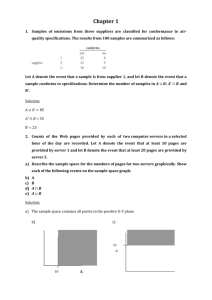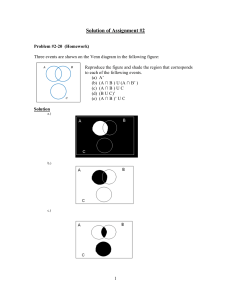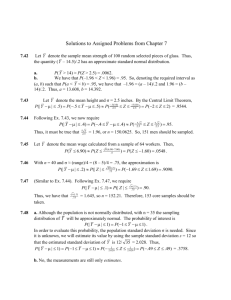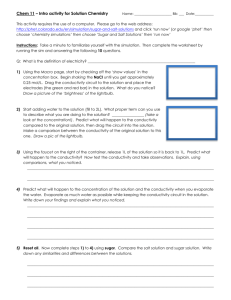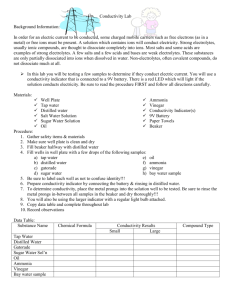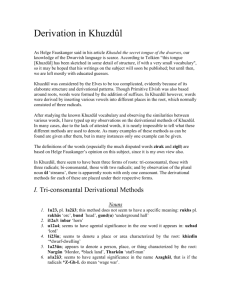Solutions to STA 4032 Assignment #1
advertisement
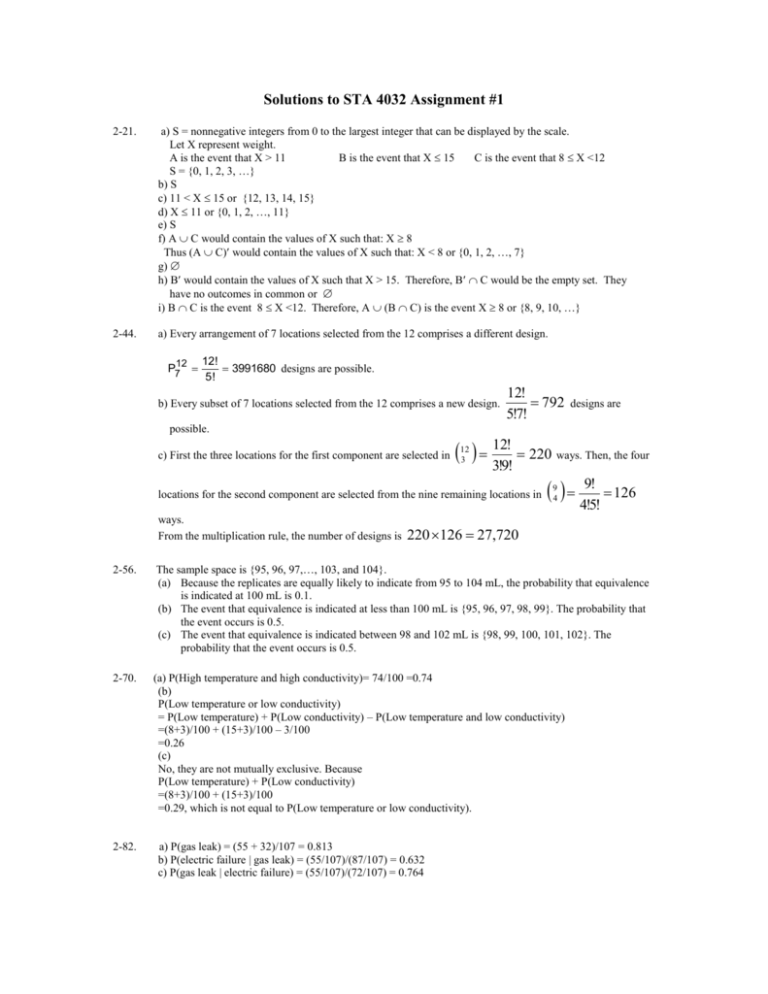
Solutions to STA 4032 Assignment #1
2-21.
a) S = nonnegative integers from 0 to the largest integer that can be displayed by the scale.
Let X represent weight.
A is the event that X > 11
B is the event that X 15
C is the event that 8 X <12
S = {0, 1, 2, 3, …}
b) S
c) 11 < X 15 or {12, 13, 14, 15}
d) X 11 or {0, 1, 2, …, 11}
e) S
f) A C would contain the values of X such that: X 8
Thus (A C) would contain the values of X such that: X < 8 or {0, 1, 2, …, 7}
g)
h) B would contain the values of X such that X > 15. Therefore, B C would be the empty set. They
have no outcomes in common or
i) B C is the event 8 X <12. Therefore, A (B C) is the event X 8 or {8, 9, 10, …}
2-44.
a) Every arrangement of 7 locations selected from the 12 comprises a different design.
P712
12!
3991680 designs are possible.
5!
b) Every subset of 7 locations selected from the 12 comprises a new design.
possible.
c) First the three locations for the first component are selected in
12!
792
5!7!
312!9!! 220 ways. Then, the four
12
3
locations for the second component are selected from the nine remaining locations in
ways.
From the multiplication rule, the number of designs is
designs are
49!5!! 126
9
4
220 126 27,720
2-56.
The sample space is {95, 96, 97,…, 103, and 104}.
(a) Because the replicates are equally likely to indicate from 95 to 104 mL, the probability that equivalence
is indicated at 100 mL is 0.1.
(b) The event that equivalence is indicated at less than 100 mL is {95, 96, 97, 98, 99}. The probability that
the event occurs is 0.5.
(c) The event that equivalence is indicated between 98 and 102 mL is {98, 99, 100, 101, 102}. The
probability that the event occurs is 0.5.
2-70.
(a) P(High temperature and high conductivity)= 74/100 =0.74
(b)
P(Low temperature or low conductivity)
= P(Low temperature) + P(Low conductivity) – P(Low temperature and low conductivity)
=(8+3)/100 + (15+3)/100 – 3/100
=0.26
(c)
No, they are not mutually exclusive. Because
P(Low temperature) + P(Low conductivity)
=(8+3)/100 + (15+3)/100
=0.29, which is not equal to P(Low temperature or low conductivity).
2-82.
a) P(gas leak) = (55 + 32)/107 = 0.813
b) P(electric failure | gas leak) = (55/107)/(87/107) = 0.632
c) P(gas leak | electric failure) = (55/107)/(72/107) = 0.764
2-98.
Let A and B denote the events that the first and second chips selected are defective, respectively.
a) P(B) = P(B|A)P(A) + P(B|A')P(A') = (19/99)(20/100) + (20/99)(80/100) = 0.2
b) Let C denote the event that the third chip selected is defective.
P( A B C ) P(C A B) P( A B) P(C A B) P( B A) P( A)
18 19 20
98 99 100
0.00705
2-107.
It is useful to work one of these exercises with care to illustrate the laws of probability. Let H i denote the
event that the ith sample contains high levels of contamination.
a) P(H1' H'2 H'3 H'4 H'5 ) P(H1' )P(H'2 )P(H'3 )P(H'4 )P(H'5 )
by independence. Also, P(Hi' ) 0.9 . Therefore, the answer is 0.9 5 0.59
b) A1 (H1 H'2 H'3 H'4 H'5 )
A 2 (H1' H2 H'3 H'4 H'5 )
A 3 (H1' H'2 H3 H'4 H'5 )
A 4 (H1' H'2 H'3 H4 H'5 )
A 5 (H1' H'2 H'3 H'4 H5 )
The requested probability is the probability of the union A1 A 2 A 3 A 4 A 5 and these events
are mutually exclusive. Also, by independence P( Ai ) 0.9 4 (0.1) 0.0656 . Therefore, the answer is
5(0.0656) = 0.328.
c) Let B denote the event that no sample contains high levels of contamination. The requested
probability is P(B') = 1 - P(B). From part (a), P(B') = 1 - 0.59 = 0.41.
2-118. Let F denote a fraudulent user and let T denote a user that originates calls from two or more metropolitan
areas in a day. Then,
P(T F ) P( F )
0.30(0.0001)
P( F T )
0.003
P(T F ) P( F ) P(T F ' ) P( F ' ) 0.30(0.0001) 0.01(.9999)




